Taxco, Guerrero 作者: 来源: 发布时间:2021-11-15
1.Population and Area
Pop: 98,854 (munip.)
Area: 347 km2 (munip.)
Elev: 1778 masl
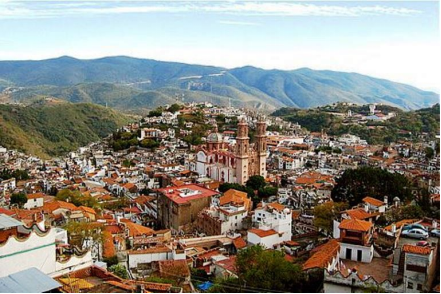
Taxco location in Mexico within the state of Guerrero
https://goo.gl/maps/9haWspUmwQBxiXyc6
2. Natural geography
Nature and weather
Flora and fauna
The vegetation that predominates in the municipality is the low deciduous forest, characterized by the change of foliage in the dry season, the main species being lysiloma, bahamensis and xotermani, there are also pine and oak forests composed of different species.
In relation to the fauna, there are still varied and delicate species such as: deer, hawk, hawk, pigeon, buzzard, huilota, turtledove, birds (of various kinds), rabbit, badger, raccoon, skunk, armadillo, iguana, snake, rattlesnake, lizard, rat, scorpion, fox, coyote, wildcat, opossum and opossum. In addition to its flora and fauna, Taxco has hydrological resources among which are its rivers, streams and lakes; also, the soils of the municipality are very suitable for the development of agriculture and livestock. The municipality has important deposits, among the most outstanding are those of gold, silver, lead, copper and zinc.
Köppen Classification: Oceanic Subtropical Highland Climate
The subtropical highland variety of the oceanic climate exists in elevated portions of the world that are within either the tropics or subtropics, though it is typically found in mountainous locations in some tropical countries. Despite the latitude, the higher altitudes of these regions mean that the climate tends to share characteristics with oceanic climates, though it also tends to experience noticeably drier weather during the "low-sun" season. In locations outside the tropics, other than the drying trend in the winter, subtropical highland climates tend to be essentially identical to an oceanic climate, with mild summers and noticeably cooler winters, plus, in some instances, some snowfall. In the tropics, a subtropical highland climate tends to feature spring-like weather year-round. Temperatures here remain relatively constant throughout the year and snowfall is seldom seen.Without the elevation, many of these regions would likely feature either tropical or humid subtropical climates.
The Köppen Climate Classification subtype for this climate is "Cwb". (Oceanic Subtropical Highland Climate).
The average temperature for the year in Taxco is 71.4°F (21.9°C). The warmest month, on average, is April with an average temperature of 75.2°F (24°C). The coolest month on average is December, with an average temperature of 68.5°F (20.3°C).
The highest recorded temperature in Taxco is 111.2°F (44°C), which was recorded in May. The lowest recorded temperature in Taxco is 46.4°F (8°C), which was recorded in January.
The average amount of precipitation for the year in Taxco is 47.8" (1214.1 mm). The month with the most precipitation on average is September with 10.0" (254 mm) of precipitation. The month with the least precipitation on average is February with an average of 0.3" (7.6 mm). In terms of liquid precipitation, there are an average of 82.4 days of rain, with the most rain occurring in June with 16.2 days of rain, and the least rain occurring in February with 0.7 days of rain.
https://www.weatherbase.com/weather/weather-summary.php3?s=912122&cityname=Taxco%2C+Guerrero%2C+Mexico&units=
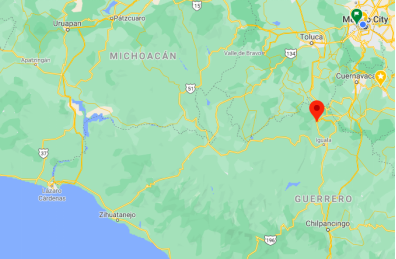
Getting there and around
Get there
By plane – The closest airport to Taxco is the Cuernavaca airport, although most visitors to Taxco will arrive at Mexico City’s airport.
By car – Driving to Taxco is fast and efficient using the toll-road from Mexico City south of Highway 95D. Taxco is beyond the colonial city of Cuernavaca and will take you around 2 – 3 hours to get to from the capital.
By bus – You can travel to Taxco on a luxury bus from Mexico City (southern bus terminal, known as Taxqueña) or from Cuernavaca. The trip takes around three hours from Mexico City or less than two hours from Cuernavaca. The buses leave frequently with services every day of the week.
https://www.mexperience.com/travel/colonial/taxco
Car Rental – To explore Mexico’s provincial towns and cities—including its beach locations and the scenery and attractions near them— consider renting a car for your visit. Having your own car will give you more flexibility than using public transport options and, in some cases, offer you access to places which are otherwise difficult to visit without the use of a car.
COVID19 – International entry into Mexico from United States
Allowed for: All visitors arriving by air. Mexico land borders are closed to non-essential travel
Restricted for: There are no current restrictions.
Get around
Local Buses – Local buses and mini-buses (combis or micros) are available locally for a fraction of the cost of a taxi around town. You need to speak Spanish to be able to ask for directions or ask the driver to tell you where to get off.
Besides using your feet to get around this very walk-able town, try the local transportation. Known as combis, these mini-buses are an economical way to get around town. To get to the town center, look for the combis that have “Zocalo” written on the windshield.
Taxis – Taxis in most of Mexico’s towns and cities are not metered, so agree your price before you get in. Taxi travel is very affordable in Mexico, in comparison to the USA, Canada and Europe, and so provides a viable means of public transportation in Mexico. Your hotel can arrange taxis for you; some post their rates on a board in the lobby; taxi hotel rates are usually higher than cabs you hail off the street. If you speak Spanish, you will have a distinct advantage and be able to negotiate a price with the driver.
Uber is expanding rapidly across Mexico and now offers services in cities across the country, including: Mexico City, Toluca, Cuernavaca, Puebla, Querétaro, León, Aguascalientes, San Luis Potosí, Guadalajara, Monterrey, Hermosillo, Tijuana, Mexicali, and Mérida. Uber has been adding Mexican cities to its network every year, check for availability when you arrive at your destination in Mexico.
Cabify and Didi are also developing and currently operate in cities including Mexico City, Toluca, Monterrey, Puebla, Querétaro and Tijuana. Check for availability in the city you are visiting.
These services offer people with smartphones a way to book a cab through a mobile app for a pre-agreed price. Fares are comparable with Sitio type cabs, and sometimes trade at a premium to this when local demand increases.
https://www.mexperience.com/transport/taxi-travel-in-mexico/#51
3. ECONOMY
GDP: 4 957.8 M MXN (2010)
https://www.researchgate.net/publication/323024442_Estimacion_no-parametrica_del_producto_interno_bruto_de_los_municipios_de_Mexico
4. Industry characteristics
Silverwork and tourism related to Taxco's status as a silver town is the mainstay of the economy. Mining is no longer a major employer in the city; the last major mining operation on the outskirts of town, Industrial Minera México S.A., phased out operations beginning in 2007 due to the depletion of reserves and labor problems. Most commercial activity related to silver is the production and sale of silver jewelry, silverware and other goods. Commerce in silver here is both regional and international. Streets in the town are filled with silvershops selling jewelry, silverware and other goods. The city has been named one of Mexico's "Pueblos Mágicos" (Magical Towns) due to the quality of the silverwork, the colonial constructions and the surrounding scenery.
5. Attractions
Colonial Center
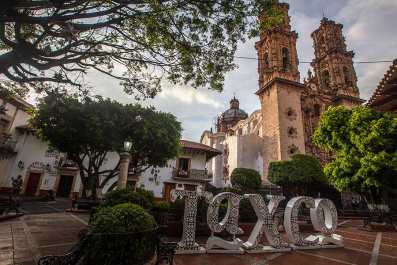
The center of the city has been excellently preserved and has a great colonial feel and atmosphere about it. The streets are cobbled and steep; small alleyways lead off the roads and some eventually break open into quaint little plazas.
Taxco is an authentic colonial city. It has been declared a national heritage site by the government and building regulations here are strict—take a look at the local gasoline station to see how keen they are to keep the place looking and feeling colonial.
By night the town lights up softly, adding a wonderful feel and atmosphere to the whole place; the lighting, coupled with fewer people as day-trippers leave, changes the ambiance of the town as it becomes more relaxed and romantic.
Taxco also has several noteworthy churches; the most magnificent, Parroquia de Santa Prisca, is on Plaza Borda (the Main Square) and its pink stonework is revered world-wide. The interior decoration here is also magnificent: marvel at the of the gold-covered altars and the exquisitely sculpted figures. There are seven other colonial-era sanctuaries that noteworthy: Capilla de Santa Veracruz, Capilla de la Santisima Trinidad, Capilla de San Miguel Arcangel, Capilla de la Virgen de Guadalupe and Ex-Convento de San Bernadino de Siena
Museums and Art in Taxco
Casa Borda Centro Cultural
The eighteenth century home of benefactor Jose de la Borda, this magnificent mansion sits on the western end of Plaza Borda. It exhibits sculptures, paintings and photos by artists from the state of Guerrero, and serves as the town’s main cultural center.
Museo de Guillermo Spratling
This museum is named after the great twentieth century American patron of the city, William Spratling, who opened a silver workshop here, producing unique silver designs which skillfully combined pre-hispanic motifs and modern art-deco styles. His love and promotion of the city brought about its economic revival. The museum hosts pre-Columbian works of art from Spratling’s private collection—the inspiration for many of his designs. You can also see some fine examples of Spratling’s signature silver design work in the form of jewelry, tableware, and other decorative pieces. To see more of his silver work, you’ll need to visit the Rancho Spratling (see below), located in Taxco Old Town.
Museo de Arte Virreinal
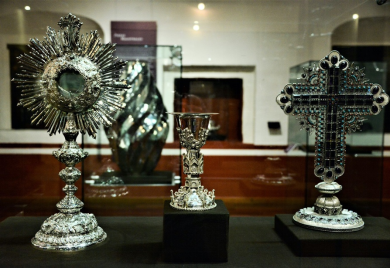
Built in the sixteenth century, this Moorish-influenced grand edifice is one of Taxco’s oldest colonial houses and exhibits works of religious art from the colonial period. Among its small and modest collection are relics taken from Santa Prisca including a well-preserved example of a colonial funeral altar.
Taxco’s panoramic views
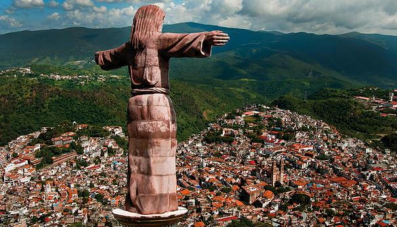
One of Taxco’s main attractions are its topographical vantage points from which to admire a sprawling carpet of green hills, valleys, and cliffs. You will find several great vantage points in and around town, but two of the best for panoramic views of the town and surrounding mountains are the Monte Taxco and the Cristo Monumental.
Cristo Monumental
Opened in 2002, the Cristo Monumental (Christ Monument) is now one of Taxco’s most prominent landmarks and an exceptional vantage point. The towering statue of Christ with outstretched arms (reminiscent of Rio’s famed Cristo) stands atop Cerro de Atachi. The statue itself is three meters in height set on a pedestal and looks over Taxco like a protective symbol. You can walk (you’ll need to be fit for the steep climb) or take a taxi up to the monument.
Monte Taxco
The only cable car system in town leads straight up to a four-star hotel resort named Monte Taxco. Go to the north side of town—just off Avenida de los Plateros—and look for the signs to the teleferico (cable car station). There’s a small fee to pay, and on the cable run you’ll enjoy an eye-catching ascent over a deep gorge with good views across the city and the surrounding mountains. Named for its location, the Monte Taxco Hotel has a restaurant and bar which is precisely positioned to give you a panoramic view of Taxco and the surrounding natural landscape.
https://www.mexperience.com/travel/colonial/taxco
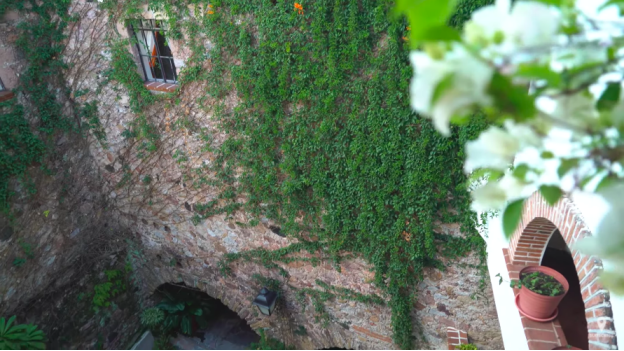
RAVEL GUIDE | Things to do in TAXCO, MEXICO in 48 HOURS
https://youtu.be/hoQLJ4SoLtE
6. History
The name Taxco is most likely derived from the Nahuatl place name Tlachco, which means "place of the ballgame". However, one interpretation has the name coming from the word tatzco which means "where the father of the water is," due to the high waterfall near the town center on Atatzin Mountain. "De Alarcón" is in honor of writer Juan Ruiz de Alarcón who was a native of the town. Like many municipalities in central Mexico, the municipality's coat-of-arms is an Aztec glyph. This glyph is in the shape of a Mesoamerican ballcourt with rings, players and skulls, derived from the most likely source of Taxco's name.
Before the arrival of the Spanish in Mexico, the indigenous community known as "Taxco" was not located where the modern city is now. The name referred to a village about ten kilometers to the south, which is now referred to as Taxco El Viejo (Old Taxco). In pre-Hispanic times, this village was the most important in the area as it was the seat of the Aztec governor who presided over tribute collection in the surrounding seven districts. The modern Spanish town of Taxco was founded by Hernán Cortés in an area previously known as Tetelcingo, because of the abundance of silver here.
Mining here began in the pre-Hispanic period with natives extracting a number of stones for decorative and ritual purposes. The Spanish discovered silver lodes here in around 1532, which started commercial silver mining in the area. Mining operations in the area during the early colonial period was carried out mostly by mining haciendas such as the Hacienda del Chorrillo and the Hacienda San Juan Bautista, established by Cortés or his knights. In the mid 18th century, José de la Borda arrived to Taxco and started more modern operations in mines called Pedregal, El Coyote, San Ignacio and Cerro Perdido.
For most of the colonial period, the area was sparsely populated, including the town of Taxco itself. For this reason, it was governed as a dependency of Mexico City. When the modern state of Guerrero was created in 1850, Taxco was chosen to be the seat of the municipality of the same name. Since it was the only town of any size in the area, the town was taken a number of times during a number of different conflicts. During the Mexican War of Independence, it was taken by Hermenegildo Galeana in 1815. During the Reform Wars, it was taken by Porfirio Diaz in 1865. During the Mexican Revolution, it was taken by Jesus Moran and Margarito Giles in 1911, and occupied by Carranza's forces in 1916.
Silversmithing was reinvigorated in Taxco by American William Spratling, who moved to the town in the 1920s, creating silver design workshops and exported items, mostly to the United States. With its fame for silversmithing, tourism became a major economic force in Taxco.
The colonization
In 1521, a Spanish expedition commissioned by Hernán Cortés sent a group of soldiers to search for tin in order to combine with copper to produce military canons. The expedition returned with some mineral samples that appeared and were believed to be tin. After testing the light-colored metal, they discovered that it was the precious metal silver. Soon after, Cortés sent another party to explore the region. The Spanish colonists quickly began construction on a new community named Taxco, named after the Indian village several kilometers away. They discovered silver ore in 1534, and during the next 200 years, Taxco became an important community for the Spanish mining industry. Later, 2 brothers, Francisco and José De La Borda, arrived in Taxco from Spain in order to build their fortune with silver.
7. Other Information: Holy Week in Taxco
In Taxco, the processions and ceremonies of Holy Week are elaborate and have gained international fame. Between Palm Sunday and Easter Sunday, there are ten major processions, six during the evening and four during the day. Most processions are about two and a half kilometers long and take about two hours to complete. These commemorations date back to at least 1622 when they were begun in the atrium of the Church of the Ex monastery of San Bernardino de Siena. Now these processions and ceremonies center of the Santa Prisca Church.
They begin on Palm Sunday, when vendors, mostly from the small outlying village of Tlamacazapa, crowd around the church to sell palm leaves woven into intricate designs. Most designs are variations of a crucified Christ but there are others, like floral designs, as well. A wooden carving of Christ on a donkey leaves another outlying village, Tehuilotepec, and marches into Taxco to arrive to the Santa Prisca Church with much fanfare. The first sign of the procession is a large number of children on bicycles, each with palm leaves attached to the front. Next come drummers and people dressed as the Twelve Apostles, walking barefoot. Last comes the sculpture of Christ, with a canopy of flowers and palms, which is surrounded by a crowd of people waving palms to be sprinkled by holy water by the priests.
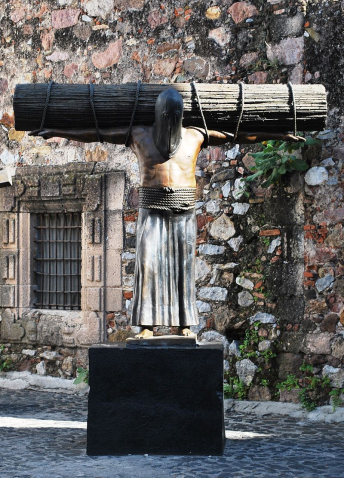
Processions occur each day of the week and grow more solemn as Good Friday approaches. The conquistadors brought the old medieval practice of painful and bloody self-penitence to Mexico from Spain about 500 years ago. Since this concept was very similar to Aztec blood rituals, this practice was easily adopted. Despite efforts by authorities in most parts of Mexico to suppress this tradition, it still reappears. However, in Taxco, this practice is not only not suppressed; it has evolved into forms unique to the city. Monday, Tuesday and Wednesday of Holy Week is dedicated to processions made by three major religious cofradias, or brotherhoods, who spend this week doing penance, and thus called “penitentes.” There are three main cofradias in Taxco, Animas, Encruzados and Flagelentes. All penitentes wear long black robes cinched at the waist with a horsehair belt, and a black fabric hood with only eyeholes. These penitentes are never seen in public without the hood as to remain anonymous.
Animas penitentes have chains attached to their ankles that rattle as they walk. These walk bent at the waist 90 degrees carrying small crosses or lighted candles. Because of this, members of this cofradia are referred to as the “bent ones.” If the procession stops, they are allowed to rest only by going down on hands and knees. This is the only cofradia that permits women as members, who drag individual chains in the procession. The men are chained together in groups of twenty. Since they must always face the ground, these penitentes have attendants which guide them during the procession.
The Encruzados walk in procession, not nailed to a cross but rather with a bundle of thorned blackberry canes tied across their bare back and outstretched arms. The bundles typically weigh between 40 and 50 kilos. In each hand, the penitente carries a lighted candle. The weight and position of the bundle forces the penitente to stoop slightly. The only rest is through attendees who help with the weight for the periods when the procession does not move.
The Flagelantes walk the entire procession shirtless and carry a large wooden cross, which can weigh over 100 pounds in the crook of their arms. In their hands they carry a rosary and a whip with metal points on the end. At certain times and places, they hand the crosses to attendees, kneel and swing the whips over and onto their backs. This is done on alternating sides, creating two bloody areas. This is repeated every night during Holy Week, reopening the wounds from the night before.
Another type of “penitente” are those who carry the large wooden statues of the major figures of Holy Week. In other parts of Mexico, these personages are played by townspeople, but in Taxco, they are represented by large wooden statues that are kept in various neighborhoods and villages in and around Taxco. These statues are carried in processions on Palm Sunday, Maundy Thursday and Good Friday.
The morning of Maundy Thursday is dedicated to a recreation of the Garden of Gethsemane in the front atrium of the Church of Santa Prisca, done with laurel branches, flowers, caged birds and a statue of Jesus. In the afternoon, the quiet is broken by men dressed as Roman soldiers looking for Jesus, as he has been sentenced to death. A townsperson playing Judas Iscariot also roams the streets, with greasy hair, a yellow tunic and rattling thirty pieces of silver. The Jesus statue in the Garden is replaced by one depicted blindfolded and with hands bound behind its back. This statue is taken to a “jail.” Penitentes and the Roman soldiers watch over this Christ statue all night rattling chains. The “Procession of the Christs” also happens this night with over 40 representations of the crucified Christ wandering the streets until morning.
On Good Friday, the Christ statue is taken from the “jail” and brought to the Santa Prisca Church for a reenactment of the Crucifixion. Inside and outside the church, the penitentes continue the penance they started earlier in the week. After the crucifixion, the statue is taken for its “sacred interment” which is a very solemn procession through the streets. That night, hundreds move through the streets carrying candles. Saturday is quiet until the mass of the resurrection late in the evening at the Santa Prisca Church. The church overflows with people. Outside in the main plaza are the Roman soldiers. When they receive word from the Church that the Christ has risen, they fall to the ground en masse, becoming believers. Most of Easter Sunday is a day of recovery from the events of the past week. Some youths will sing and walk through the streets accompanied by the “Savior Shepherd” However, most people spend the day at home.
8.Contact Information
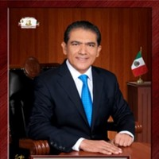
City Mayor: Marcos Efrén Parra Gómez
Contact number: +52 (762) 622 0125
Govt. Office Address: Calle Benito Juárez 21, Barrio del Exconvento, CP. 40240 , Taxco, Gro.
FB: https://www.facebook.com/marcosparrag
Website: https://taxco.gob.mx
